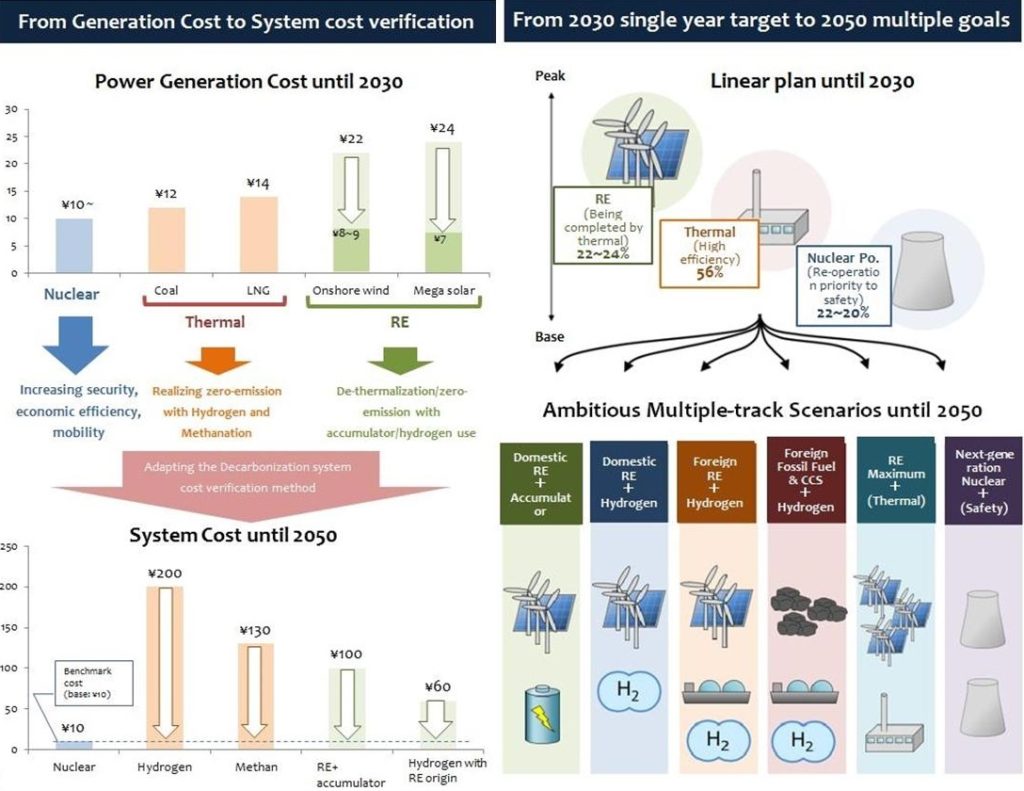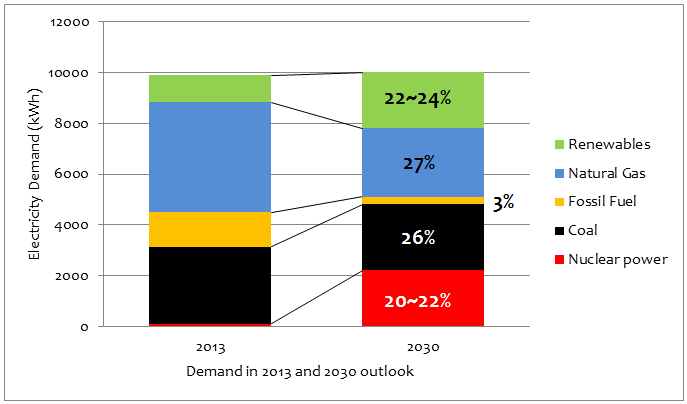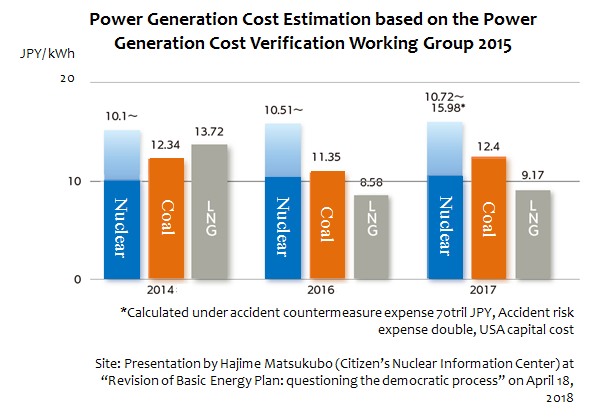Since August 2017, the Strategic Energy Plan (SEP) revision has been discussed by the ”Strategic Policy Committee”, one of the deliberative councils of Ministry of Economy, Trade and Industry (METI). The new Plan is to be decided by the Cabinet in the summer 2018. It is now under public comment procedure on the draft of the fifth Basic Energy Plan from May 19th to June 17th.
Every once in three years, the SEP is reviewed. Four year has passed since the last revision, which took place in 2014. Within this period, the Paris Agreement was adopted in 2015 and came in effect in 2016. This revision could be an opportunity to make a change in future energy direction of the country towards decarbonization, especially toward coal free. However, the draft of the fifth SEP follows the existing policy direction without any major changes. Even though the world trend has drastically shifted, nuclear and coal remains as “base-load” power sources. A growing number of NGOs and citizens have been protesting against this plan, yet these voices are not reflected. The draft of the fifth SEP has many problems as below. The deadline of public comment is on June 17th. Let’s use our voice to make a change.
2030 Energy Mix Target remains the same
The reason of Japanese government emphasizing “limited availability of energy resources” is that to reduce the dependence risk by diversifying the supply resources. Based on this idea, the energy mix towards 2030 is; coal 26%, LNG 27%, nuclear 22~20%, and renewables 22~24%.
Although 2011 Fukushima nuclear accident is causing broad radioactive contamination and forcing many people to flee from their home even today, this lesson has not sufficiently reflected on. Far from that, the ratio of nuclear power in energy mix (20~22%), which has been accused as unrealistic, does not revised and kept as a target to realize. As for renewable energies, it calls for efforts to make renewables as “main source of power supply” considering the cost reduction in the world energy market. However, as a whole, it is clear that this plan depends on nuclear power as the main “low carbon source”. The graph presented together with as the fifth SEP draft below shows that they try to make nuclear look much cheaper compared to other sources including renewable energies by introducing new verification system. It is implausible to believe that this plan tries to make renewables as the main source of power supply.

Coal remains as “base-load”
The fact that the energy mix has not changed means that the ratio of coal remains same as 26%. It still says that the “highly efficient” technologies “reduce burden on the environment” which only leads the misunderstanding. Additionally, it mentions these technologies “reduce the long-term burden on the environment” meaning that coal will be used in long run. The CO2 emission of IGCC, the so-called “highly efficient” technology, is above the amount of petroleum thermal power, and even double the amount of highly efficient natural gas thermal power. Additionally, it keeps saying that “cost per kWh is the cheapest amongst the fossil fuels”. However, the market price of LNG is already cheaper than coal; this statement does not reflect the current situation.
Past several years have seen the significant change in relation to coal, such as the investment withdrawal (divestment) has had an great impact on the increasing risk amongst coal industry. From the policy perspective, some of the developed countries announced to phase out coal. Some of the background factors of this trend are the enforcement of the Paris Agreement and the rapid progress in renewable energy technologies. As such, the world is heading towards the decarbonized society. The risk of coal being standard asset is becoming more and more apparent. Japan’s position to stick to coal will only lead a negative impact on the Japanese industry as a whole.
Coal behind Hydrogen
In the draft of the fifth SEP, the word “hydrogen” is studded more than ever; it appears 131 times. It emphasizes hydrogen as the future choice that does not emit CO2. Hydrogen is mentioned as one of “variety of options”. Additionally, it is used to complement renewable energies combined with battery technology. However, even behind hydrogen, there is a use of coal.
Australia, one of the promising import destinations, will gasify lignite to produce hydrogen. It is this process that will emit enormous amount of CO2. However, there would be no carbon dioxide emission when being used, which is why hydrogen is placed as “environmentally friendly energy”. Additionally, the government suggests a technology called Carbon Capture and Storage (CCS). Through this, it is possible to capture carbon dioxide and deposit it underground. As much as this is a prospective research and development, there are problems that need to be solved. Even if this were realized, there would be a limitation from the perspective of social acceptance, especially in the earthquake-prone country like Japan. In any case, since zero-emission is the fundamental target under Paris Agreement, relying on such a highly uncertain technology is irresponsible.
Future Energy Policy
In this fifth SEP draft, stating renewable energies as “main source of power” is a first step. On the other hand, there remains a doubt whether this statement means that the country is heading to 100% renewables future or not, since there is no concrete target suggested. In the midst of the rapid global change, this attitude of stubbornly keep the energy mix only reveals the lack of foresight. This decision which is far behind the world course could be decided at the Cabinet as the “fifth SEP”.
Moreover, as mentioned above, Japan is often mentioned as a country with scarce resources in the discussion of energy issue. This makes the discussion looks as if it is inevitable to depend on coal. However, considering the broadening choice of small-scale decentralized renewable energies, we also need to tackle with policies and measures to accelerate to shift energy system toward decentralized clean energies.
The fifth SEP should declare the exit from nuclear and coal, and show clear direction towards the dynamic transition through increasing energy efficiency and expanding the use of renewable energy. Coal, the most intense emitter of carbon dioxide, should be immediately abandoned. If the current situation were continued, it would be impossible not only to follow the Paris Agreement but also to realize the target of 80% emission reduction set by Japan itself. As a party of the Agreement, and as a member of this planet, Japan needs to act responsibly. Instead of nuclear and coal, Japan should set more ambitious and concrete target of renewables in order to promote its use.
Currently, most of the existing coal-fired power plant plan in Japan is proceeding as a base-load electricity and on the basis of energy mix which set 26% of coal use. In other words, how coal is placed in the SEP actually gives an incentive for the business operators to promote coal fired power. In order to change the situation surrounding the coal use in Japan, it is inevitable to revise the current SEP. The ongoing public comment is one of the ways to raise your voice. This can be an opportunity to talk about the issue of energy future with friends or family.



